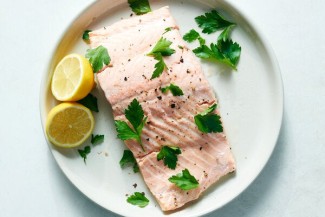Microwave Salmon

This easy approach to poached salmon turns out buttery, flawless fish. The trick to getting domino-fall flakes of salmon? Microwave it in a simple saltwater solution at full power and let it rest for an equal amount of time before serving. The water both seasons the fish and helps it cook evenly. You can add a teaspoon of sugar or syrup to the saltwater to add a subtle sweetness, and aromatics, such as rosemary or dill to create additional layers of flavor. If you have time, you can brine the salmon as long as overnight in the refrigerator, which helps reduce the albumin (the harmless white protein that gathers on the surface of the fish during cooking). Most microwaves range in power levels from 600 to 1200 watts. This formula was developed in a 1000-watt microwave that boils one cup of cold tap water in 2 minutes. Cooking speeds on microwaves vary, even among those with the same wattage, so this recipe calls for checking your fillet early to avoid overcooking.
2 cups lukewarm water
2 teaspoons fine or coarse sea salt
1 (12-ounce) salmon fillet, preferably skin on and 1½ inches thick (see Tips)
Fill a microwave-safe dish that can hold the salmon snugly with the water. Add the salt and stir to dissolve. Add the salmon, skin side down, and baste by spooning the saltwater over it. The top of the fillet should stick out of the saltwater (see Tip). Loosely cover with a microwave-safe lid or plate.
Microwave the salmon at full power (high) for 3 minutes. Check for doneness by inserting a sharp paring knife into the center of the fillet. If it slides in easily without resistance, the salmon is done. It should take about 4 minutes for medium-rare doneness and about 5 minutes for medium, but the time may vary because every microwave cooks differently.
Let the fish sit, still covered in the dish, for 4 to 5 minutes. Remove from the water and serve.
TIPS
This formula below was designed for farm-raised Atlantic salmon, which has a high fat content. For wild varieties, which are leaner and less thick, reduce cooking and resting times by half.
The salmon should be surrounded by but not submerged in the water. If the dish is larger, add more saltwater as needed, dissolving 1 teaspoon salt in each additional cup of lukewarm water.
Nutritional analysis per serving (2 servings)
354 calories; 23 grams fat; 5 grams saturated fat; 0 grams trans fat; 6 grams monounsaturated fat; 7 grams polyunsaturated fat; 0 grams carbohydrates; 0 grams dietary fiber; 0 grams sugars; 35 grams protein; 946 milligrams sodium